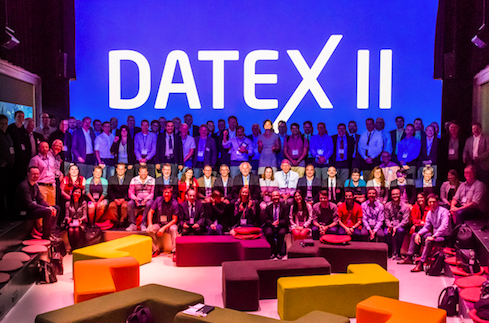On the 23rd and 24th of May the 5th DATEX II Forum was held in the LEF Future Meeting Center in Utrecht, the Netherlands. 143 participants from 20 different countries came together to learn more about the standard, to exchange knowledge with the rest of the community and to enter into discussions about the future.
Present were both new and experienced ITS system users, policy and decision makers, software developers, information architects as well as ITS consultants. Various domains were also represented, such as road authorities (motorway, urban, interurban), service providers, map makers, the ITS industry, C-ITS and knowledge institutes.
To serve this wide range of attendees, the programme included many different sessions in parallel using both the interactive working methods and environments. This approach allowed for a lot of interaction and discussion between presenters and the audience. The programme also offered for plenty of time to network during lunch and coffee breaks, as well as during sessions and at the social event.
This 5th DATEX II Forum was dedicated to the launch of DATEX II version 3. One of the major enhancements of DATEX II Version 3 is that it is now possible to make a profile that is completely tailored to a use case. Whether the profile is small or extended, it will just contain the elements that you need. Version 3 also ensures that different profiles are compatible and interoperable. Thanks to a technology update (UML2, XMI2.1), Version 3 is now faster and more user-friendly compared to its predecessor. Other features and novelties include the Modular Approach (packaging structures, namespaces, …) allowing you to do parking without having to worry about travel times, the possibility to extend enumerations, a new web version of the fast schema generation tool, a new, second experimental transfer syntax (JSON Schema) and many non-backward compatible model improvements based on input from the community collected of the years. Of course, the data model was improved as well and received a number of new or modified elements or a new structure based on user requirements. The methodology behind DATEX was also updated.
The program included several substantive sessions in parallel, in which the attendees set to work on different topics and issues through interactive working methods and environments. The program also offered sufficient time to network during lunch and coffee breaks, the sessions themselves and during the evening program in the Paushuize (Pope House Utrecht) where the Dutch National Data Warehouse for Traffic Information offered drinks to the participants in the context of its 10-year anniversary.
The Forum ended with the “Declaration of Utrecht”: a non-binding guidance document for the future of DATEX II. It consists of 10 statements that were compiled during the Forum, derived from the results of the substantive (‘break-out’) sessions, answers from the platoons and other highlights of the program. The Declaration of Utrecht contains the concluding statements of the Forum and shows how DATEX II can further develop in the coming years with regard to topics such as information exchange, stakeholders and outreach, open data and user support.
The report on the 5th DATEX II Forum can be found below. Photos that were taken and presentation slides used at the Forum can be found here. Please visit our LinkedIn page for regular news updates and leave your ideas and remarks on our discussion forum.


